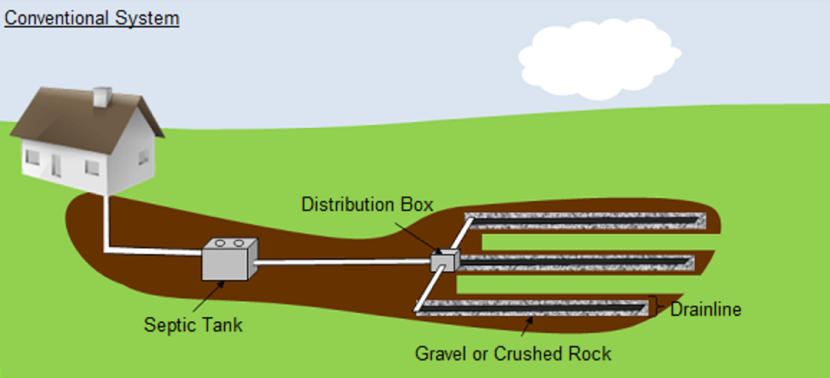Types of Septic Tanks
All onsite wastewater systems have a septic tank as the first step. The purpose of the tank is to collect and settle solids from liquids. The inlet side allows solids to settle to the bottom where they degrade from bacteria and enzyme action into sludge. The outlet side is mostly “clear” water. These areas are separated by a baffle which allows water into the outlet side, but keeps most of the solids in the inlet side. Some solids will accumulate in the outlet side but will be minimal. There also should be an outlet tee which prevents any floating scum or solids from entering the field lines. Any tanks installed after 2006 should also have an outlet filter, which further prevents solids from entering the field lines, but requires a riser for access to the filter for ease of routine filter cleaning.
The primary difference among septic systems is the manner of effluent disposal.
1. Conventional system
With a conventional system, there will be a header on the outside of the tank which feeds the field lines. Most field lines are 4” corrugated pipe with small holes in the bottom for water to seep through. The quantity and length of the field lines are contingent upon perk test results, soil analysis, and the number of bedrooms. Distribution boxes are sometimes used but are uncommon in our area.
2. Sequential system
A sequential system is used when there is a downward slope in the yard. There will still be a header, but the water will first enter a field line running parallel with the slope. As that line fills to capacity, the water will run down to the next level.
3. Chamber system
A chamber system works basically the same way, but instead of corrugated pipe, there is a bed covered by a dome (similar in shape to a coffin lid) with slits in the sides. The water will perk through the soil in the bottom and side of the chamber as there is no bottom to the chambers.
4. Advanced systems
A peat moss system, which is only one of many advanced systems, is used in areas near large bodies of water, or shallow soil conditions on a rock, such as is common in the Shades Mountain area or lake homes. The effluent drains (or sometimes is pumped) into a bed of peat moss, which aids in water treatment by physical filtration, chemical adsorption, and microbial assimilation, which reduces effluent contaminants by as much as 90%.






